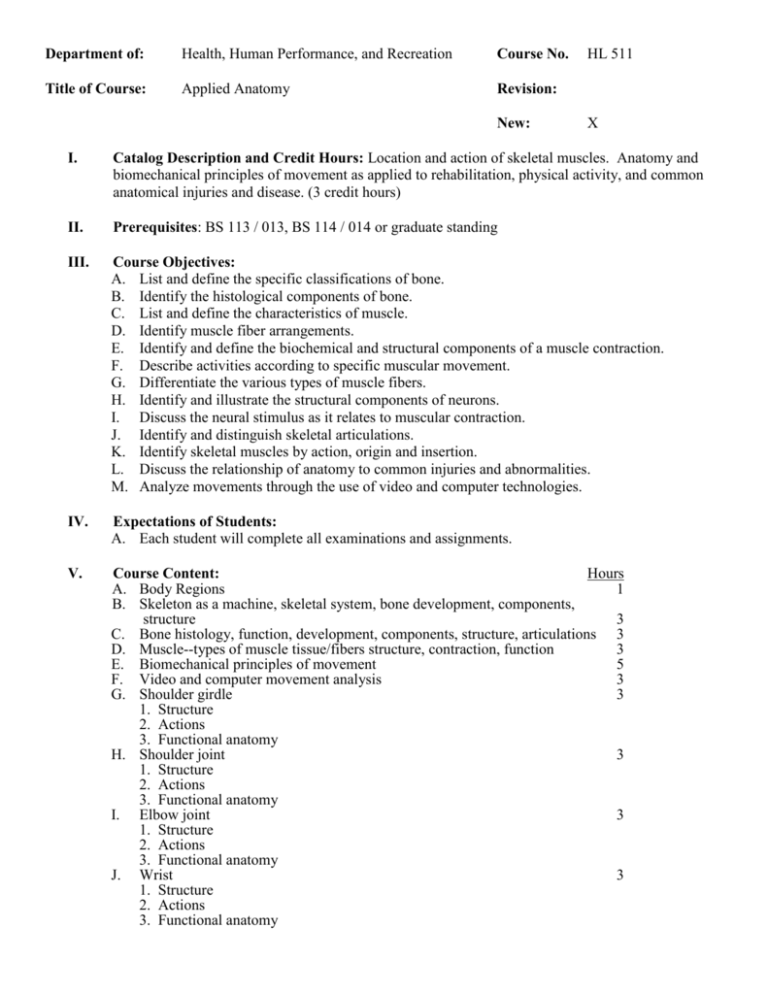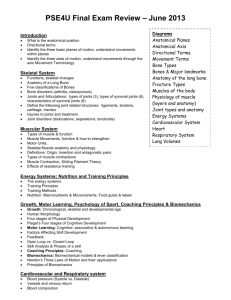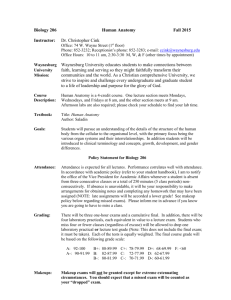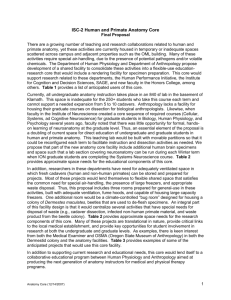HL511 - Southeast Missouri State University
advertisement

Department of: Health, Human Performance, and Recreation Course No. Title of Course: Applied Anatomy Revision: New: HL 511 X I. Catalog Description and Credit Hours: Location and action of skeletal muscles. Anatomy and biomechanical principles of movement as applied to rehabilitation, physical activity, and common anatomical injuries and disease. (3 credit hours) II. Prerequisites: BS 113 / 013, BS 114 / 014 or graduate standing III. Course Objectives: A. List and define the specific classifications of bone. B. Identify the histological components of bone. C. List and define the characteristics of muscle. D. Identify muscle fiber arrangements. E. Identify and define the biochemical and structural components of a muscle contraction. F. Describe activities according to specific muscular movement. G. Differentiate the various types of muscle fibers. H. Identify and illustrate the structural components of neurons. I. Discuss the neural stimulus as it relates to muscular contraction. J. Identify and distinguish skeletal articulations. K. Identify skeletal muscles by action, origin and insertion. L. Discuss the relationship of anatomy to common injuries and abnormalities. M. Analyze movements through the use of video and computer technologies. IV. Expectations of Students: A. Each student will complete all examinations and assignments. V. Course Content: Hours A. Body Regions 1 B. Skeleton as a machine, skeletal system, bone development, components, structure 3 C. Bone histology, function, development, components, structure, articulations 3 D. Muscle--types of muscle tissue/fibers structure, contraction, function 3 E. Biomechanical principles of movement 5 F. Video and computer movement analysis 3 G. Shoulder girdle 3 1. Structure 2. Actions 3. Functional anatomy H. Shoulder joint 3 1. Structure 2. Actions 3. Functional anatomy I. Elbow joint 3 1. Structure 2. Actions 3. Functional anatomy J. Wrist 3 1. Structure 2. Actions 3. Functional anatomy K. Hand and Fingers 1. Structure 2. Actions 3. Functional anatomy L. Spine 1. Structure 2. Actions 3. Functional anatomy M. Thorax 1. Structure 2. Actions 3. Functional anatomy N. Hip 1. Structure 2. Actions 3. Functional anatomy O. Knee 1. Structure 2. Actions 3. Functional anatomy P. Ankle and foot 1. Structure 2. Actions 3. Functional anatomy VI. VII. 2 3 2 3 3 2 Total 45 Textbook: A. Floyd, R.T. (2009) Manual of Structural Kinesiology (17th ed.). McGraw-Hill: Boston, MA. Basis for Student Evaluation: A. Undergraduate 1. Homework 2. Project 3. Written examinations 15% 15% 70% To complete the project, students must break down a simple sporting skill (upper or lower extremity) by phase and analyze the anatomical movements created during the activity, and distinguish which muscles are responsible for the movement. Common errors in the skill leading to injury will also be determined. The project will be completed using Dartfish technology. The information will be presented in written and visual form to the class. B. Graduate 1. Homework 2. Projects (2) 3. Written examinations 10% 30% 60% Graduate students will complete their first project by analyzing a complex sporting skill (upper or lower extremity) by phase and analyze the anatomical movements created during the activity. Biomechanical as well as muscular concepts will be described for each phase. The students will determine errors in the skill leading to injury. Students will follow the same process for their second project, however this time analyzing multiple subjects completing sporting activity (either upper and lower extremity) and providing a comparison that is related to current literature. Both projects will be completed using Dartfish technology. Students will present this project to the class in verbal and visual form. The weight of evaluation criteria may vary at the discretion of the instructor and will be indicated at the beginning of each course. Undergraduate Grading Scale A=90-100% B=80-89% C=70-79% D=60-69% F=59% & below Graduate Grading Scale A=90-100% B=80-89% C=70-79% F=69% & below VIII. Academic Integrity: The application of the Southeast Missouri State University Academic Honesty Policy as found in the Undergraduate and Graduate Bulletin will be fully adhered to in this course. IX. Statement of Academic Accommodations: If any member of this class feels that he/she has a disability and requires special accommodations of any nature whatsoever, the professor will work with you and the Learning Enrichment Center to provide reasonable accommodations to ensure that you have a fair opportunity to perform in this class. Please advise the professor of such a disability and the desired accommodations at some point before or immediately after the first scheduled class period.






